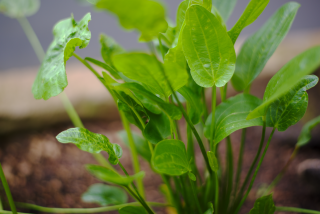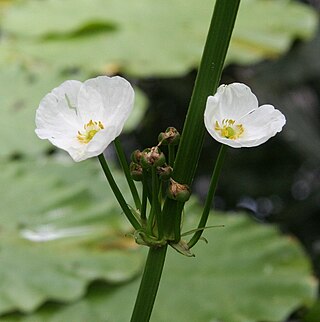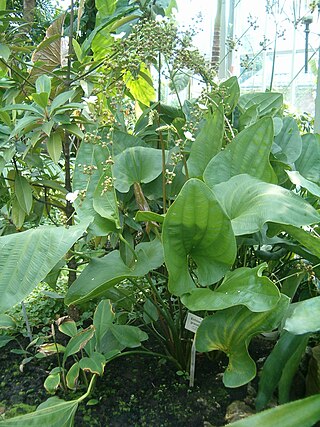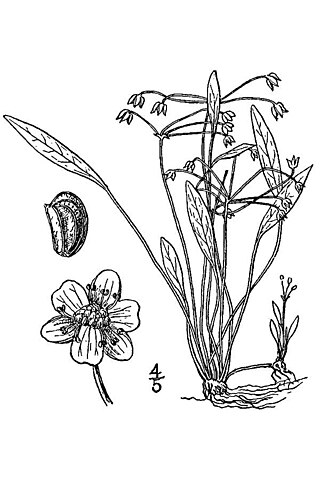
The water-plantains (Alismataceae) are a family of flowering plants, comprising 19 genera and 117 species. The family has a cosmopolitan distribution, with the greatest number of species in temperate regions of the Northern Hemisphere. Most of the species are herbaceous aquatic plants growing in marshes and ponds.

Hottonia palustris, also water violet or featherfoil, is an aquatic plant in the family Primulaceae.

Bacopa caroliniana is a flowering plant species.

Echinodorus, commonly known as burhead or Amazon sword, is a genus of plants in the family Alismataceae, native to the Western Hemisphere from the central United States to Argentina. Its scientific name is derived from Ancient Greek echius – "rough husk" - and doros – "leathern bottle" - alluding to ovaries, which in some species are armed with persistent styles, forming prickly head of fruit. Some of the species are commonly cultivated in artificial aquatic habitats.
Echinodorus horizontalis is a species of plant in the Alismataceae family. It is native to northern South America.
Echinodorus longiscapus is a perennial, aquatic plant of the Alismataceae, native to South America. It is cultivated as a pond or aquarium plant.

Echinodorus macrophyllus is a species of aquatic plants in the Alismataceae. It is native to Brazil and Bolivia.

In Rataj's taxonomy Echinodorus ovalis is in Section Cordifolii, Subgenus Echinodorus. It is related to Echinodorus cordifolius and listed by some authorities and importers as a synonym of that species, e.g. E. cordifolius 'ovalis'.

Echinodorus subalatus is a species of aquatic plants in the Alismataceae. It is native to Cuba, Mexico, Central America, Guyana, Venezuela, Bolivia, Brazil and Paraguay. It is found naturally growing in mud by the side of streams.
Echinodorus trialatus is a type of plant. In Rataj's taxonomy, E. trialatus is in Section Paniculati, Subgenus Echinodorus.

Echinodorus uruguayensis or Echinodorus osiris is a plant species in the Alismataceae. It is native to South America.

Echinodorus berteroi is an aquatic plant species in the Alismataceae It is native to the southern and central parts of the United States, as well as Central America, the West Indies, and South America as far south as Argentina.

Ludwigia inclinata is a highly variable herb from Central and South America, usually found growing emersed or submersed on the beds of dried ponds or lakes, either submerged or with emergent stems.

Rotala rotundifolia, the dwarf rotala, is a plant species often confused with Rotala indica. It is sold in the aquarium trade, but is of uncertain status.

Limnophila sessiliflora, known as dwarf ambulia, ambulis, and Asian marshweed is a flowering plant in the family Plantaginaceae.
Cryptocoryne affinis is a plant species belonging to the Araceae genus Cryptocoryne.

Echinodorus grandiflorus is a plant species in the Alismataceae. It is native to Brazil, Paraguay, Uruguay, Argentina, Venezuela and Florida.
Aponogeton abyssinicus is an amphibious plant found in east and central Africa, from Ethiopia to Malawi and Zaire. Root stock tuberous or oblong, up to 2.5 cm diameter. Submersed leaves initially strap-shaped, up to 12 cm long and 6 mm wide, continuing lanceolate to obovate, up to 8.5 cm long, 2.6 cm wide and up to 10 cm long petiolate. Blade thin and slightly transparent, with a narrowing or decurrent base and acute or obtuse apex. Adults floating, up to 50 cm long petiolate. Floating leaf blade linear to ovoid, rarely cordate, up to 16 cm long and 5 cm wide, usually considerably smaller. Emersed leaves shaped like the floating leaves, slightly leathery and shorter petiolate. Peduncle up to 45 cm long, angled, dark red to green coloration, slightly pubescent underwater, almost glabrous above water, not swollen under the inflorescence. Spathe 1.0-1.6 cm long, caducous. Inflorescence featuring two 1.5-5-cm long spikes with omni-lateral flowers; 2 tepals, violet or white coloration; 6 stamens ; 3 carpels. Fruit up to 7 x 2.75 mm large, with (4-) 7-10 seeds, sized 1-2 x 0.75 mm, double testa.
Albidella is a genus of plants in the Alismataceae. At the present time, only one species is known, Albidella nymphaeifolia, formerly called Echinodorus nymphaeifolius. It is native to Cuba and the Yucatán Peninsula.

Helanthium tenellum, the pygmy chain sword, is a species of plants in the Alismataceae. It is native to the eastern United States, southern Mexico, West Indies, Central America, South America















